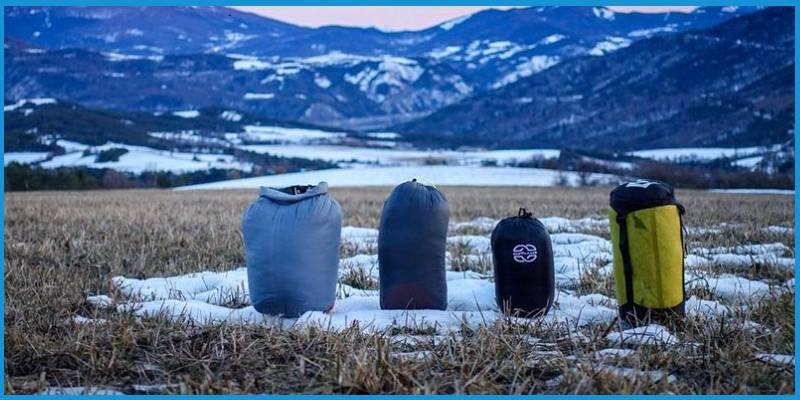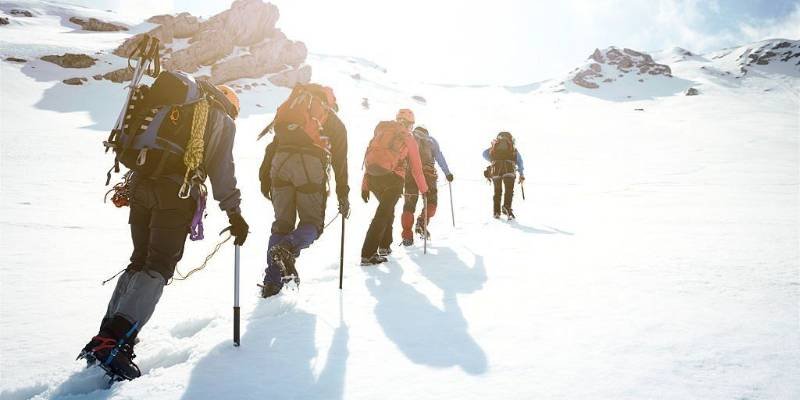Smart Tips on Hiking and Camping in the Snow
Hiking and camping adventures in the snow can be a breathtaking experience. It offers a serene and magical landscape that transforms the familiar trails into a winter wonderland. However, venturing into snowy terrain requires careful preparation and a unique set of skills to ensure both safety and enjoyment.
Indeed, you will have to overcome the cold and the almost constant humidity which greatly handicaps your progress and your comfort. To help you prepare as well as possible to avoid any disappointments during a hike or camp in winter, I have prepared a complete guide for you.
Essential Equipment for Hiking and Camping in the Snow
Above all, to go hiking or camping in the snow, you will need to equip yourself properly. Preparing your hiking bag will be quite different from a summer excursion and your backpack will undoubtedly be heavier. In addition to the classic hiking equipment checklist, you will need to think about taking various accessories.
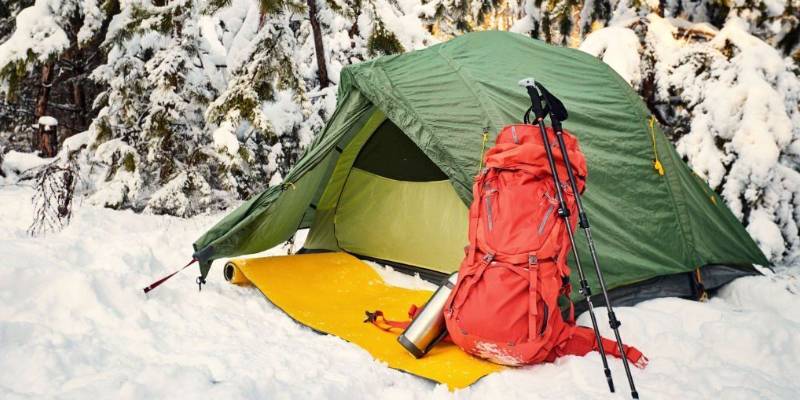
A 4-Season Tent is an Obligation
If you plan to hike over several days during the winter, the 4-season tent is a prerequisite. These are designed to withstand extreme conditions such as snow, storms and frost. Before buying a 4-season tent, check that it has a flysheet to insulate the outside and inside of the tent by capturing a certain volume of air. It is crucial to incorporate reinforcements in key areas of the tent, including the floor, seams and stays.
You will then have the choice between two types of tents:
- Tunnel: quick to erect and stable, this type of tent can offer excellent wind resistance if it is on the right axis. There is also more interior space and ventilation. However, if the wind direction changes, you will need to quickly reorient your tent.
- Geodesic: also called a dome, this tent has multidirectional wind resistance. Nevertheless, the assembly is much slower than for a tunnel tent. However, it is advisable to favor this type of structure when you advance in altitude.
Choosing a Good Sleeping Bag is Essential
The biggest enemy of a campsite in the snow is the cold. Indeed, it can range from simple discomfort to a real risk to your health. Thus, it is crucial to choose a suitable sleeping bag. For it:
- Check the temperatures indicated: the extreme temperature is not practical for regular use. It represents the hinge point where the risk of hypothermia after just a few hours of sleep becomes a concern. Stick to considering the comfort and limit temperatures for more accurate guidance on suitable gear for your camping conditions.
- Take a good look at the filling: you will have to choose between the effectiveness against the cold of feathers and duck or goose down, or the resistance against the humidity of synthetics such as Primaloft or Thermolite.
- Choose according to practicality: the design of the sleeping bag is crucial. I’m not talking about aesthetics, but practicality. Indeed, it is important that your down sleeping bag can cover both your head and your shoulders, the first two areas of heat loss in the human body.
- Consider weight: remember that you will need to carry your sleeping bag to your campsites in addition to other snow gear. It then becomes essential to choose the best possible weight/resistance to cold ratio. In the same logic, you will have to take into account the volume of your down so that it can fit or cling (without disturbing you) to your hiking bag.
To find out more, you can consult our guide on sleeping bag temperature rating.
Floor Mat – Save Your Life
The groundsheet is a must for camping in the snow. It acts as a barrier between you and the ground and allows you to retain your body heat. To ensure its effectiveness, selecting the right one is essential. Indeed, a snow mattress must be:
- Insulation: the main purpose of a mattress is that it can insulate to protect you from the cold. You will then have to choose a padding that meets this criterion while taking into account the humidity of the hiking or camping area. You can then choose between natural filling with feathers and down or synthetic insulation such as DownMat 7.
- Light: In the same idea as for the sleeping bag, your groundsheet must be able to find its place in your camping and hiking equipment without overloading you too much. For this, it is good to opt for a brand of ultra-light equipment.
- Practical: compact and easy to install; these are necessary prerequisites for a groundsheet for camping in the snow. Indeed, during the winter season, the camp must be set up quickly because of the limited sunshine duration and the cold.
To choose the best your future sleeping mat, you can consult our guide to the best camping tent carpet.
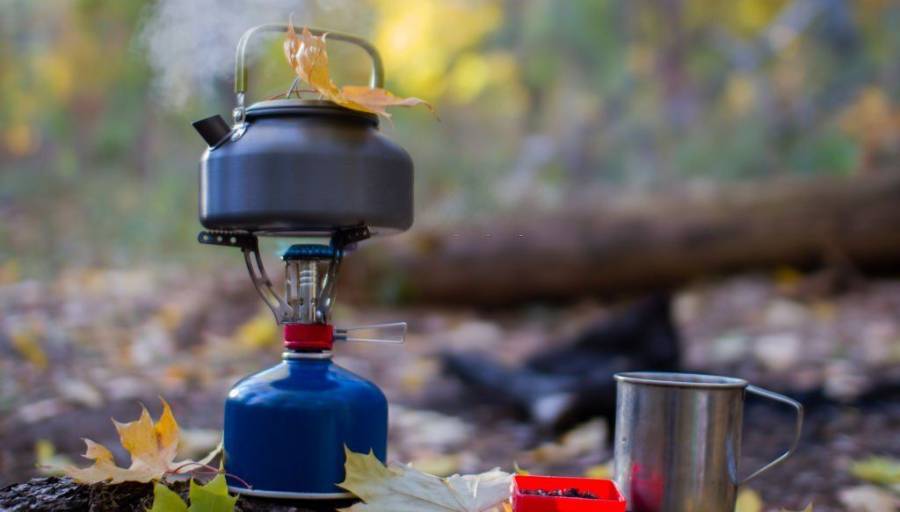
Kitchen Equipment: Stove + Food
In winter, hiking conditions are more difficult because of the cold. To feed yourself, you will have to take into account two variables:
- The stove: which can be affected by the temperature.
- Food: you will need more energy when hiking in the snow.
As for the stove, you will have several options:
- Liquids: whether gasoline, kerosene, domestic fuel or diesel, this type of stove is highly recommended when trekking in the cold because these fuels are effective even at extremely low temperatures. However, they can be difficult to use because the fuel must be pressurized with a hand pump. This will turn the liquid into vapor so that it can mix with the air. This type of stove also requires a lot of maintenance and must be cleaned on a regular basis. Finally, the risk of fire is very frequent, especially when used under a tent.
- Gas: if it was to be banned until recently due to its incompatibility with the cold, today there are new generation gas stoves called optimized stoves which can offer a certain efficiency even in difficult conditions.
- Multi-fuel: this type of stove is very interesting because it works with all types of fuel. Nevertheless, there are several negative aspects that can hinder hikers in their purchase: the price and the lack of practicality.
- Alcohol: this type of stove has many advantages such as its low cost, the ease of obtaining methylated spirits, and very intuitive use.
For food, you will have to succeed in balancing your energy needs and the load to be transported. To avoid overloading yourself, it is strongly advised to opt for freeze-dried food for its compact appearance and its rich energy content. However, these meals can be expensive. An alternative option will then be to opt for Chinese noodles which are less expensive, lighter, less bulky, and require a fairly limited volume of water to be cooked.
Warm Clothes Are Not to be Neglected
You are probably already thinking about it when hiking in the snow, it is better to be warmly dressed. Be careful though, during the day, you will be very active. Thus, by dressing too warmly, you risk sweating a lot.
However, humidity during a winter camp is to be absolutely avoided. It will be very difficult to dry your clothes and you will have a hard time keeping warm when they are wet. It is then advisable to opt for breathable clothing in order to evacuate perspiration.
I therefore advise you to dress with several layers in order to obtain the perfect balance between warmth and dryness:
- First layer: merino wool garments that are suitable for low temperatures, antibacterial, against bad odors and hydrophobic. The first layer means that this material adapts to both cold & wet weather and dry & hot weather. However, you will need to choose the right thickness for this underlayment. I recommend as thick as possible.
- Second layer: The purpose of this layer is to insulate and protect against humidity and cold. For this, the down jacket is the best in terms of comfort and insulation. You can also opt for synthetic fibers such as fleece.
- Third layer: also called outer layer, its purpose is to protect against wind and external humidity (rain) but also to evacuate internal humidity (perspiration). The best material in this term is Gore-Tex which is made up of waterproof and breathable membranes. Beware of K-ways which, against all odds, are not recommended. Indeed, this type of product causes a sauna effect which is not at all desired during a winter trek.
- The finishes: think about the gloves, hat (or balaclava), padded slippers, and scarf.
Checkout our complete guide on hiking in the winter & recommended clothing.
Water Also Essential to Protect From the Cold
Hydration is essential when hiking and even more so in cold weather. However, during a winter camp, hikers can encounter a major obstacle: frost. You must then be able to insulate your bottle, water bottle, or pocket of water as well as possible so that this precious liquid cannot freeze.
For this, I strongly recommend isothermal protection. Also, be careful where you store your water when camping in the snow to avoid finding it in the form of ice in the morning. Otherwise, you will have to thaw it using your stove, which will mean a reduction in your fuel stock.
Don’t Forget the Snow Shovel!
You can’t do without it when hiking or camping in the snow. This shovel has many uses:
- Dig a makeshift shelter.
- Clear an area for his bivouac.
- Build walls of snow to protect against the wind.
- Dig a hole to defecate.
There are many types of snow shovels. I advise you to take a light and foldable model in order to reduce the weight and volume of your winter trekking equipment.
Prepare Your Equipment Well for Camping in the Snow
In addition to this special equipment for hiking and camping in the snow, you will have to prepare your equipment as well as possible, taking into account the extreme conditions that may arise.
Beware of Shorter Days
Let’s not forget, the days are shorter in winter than in summer. Therefore, when you plan to make a camp during a trek, you will have to prepare your hikes in order to arrive at your campsite instead. This will allow you to have enough time to set up your bivouac before nightfall. Also, think about the headlamp for the night.
Choose Your Campsite Location
Once you have arrived at your destination, you will still have to find your campsite and prepare it as well as possible for the night. For this, as in summer, think about the prerequisites to know on a camp during a hike:
- Set up your camp far from the edge of a river or stream.
- Prefer the facilities provided by the parks when possible.
- Choose flat ground.
- Choose a place sheltered from the wind.
Don’t Expect the Same Refuges As in the Summer
In winter, there are far fewer refugees than in summer. Besides this, the quality and comfort of these are very different… Indeed, winter shelters are generally quite basic with few facilities. It is therefore advisable to act as if you were in a camp (minus the tent) because it could be very cold there!
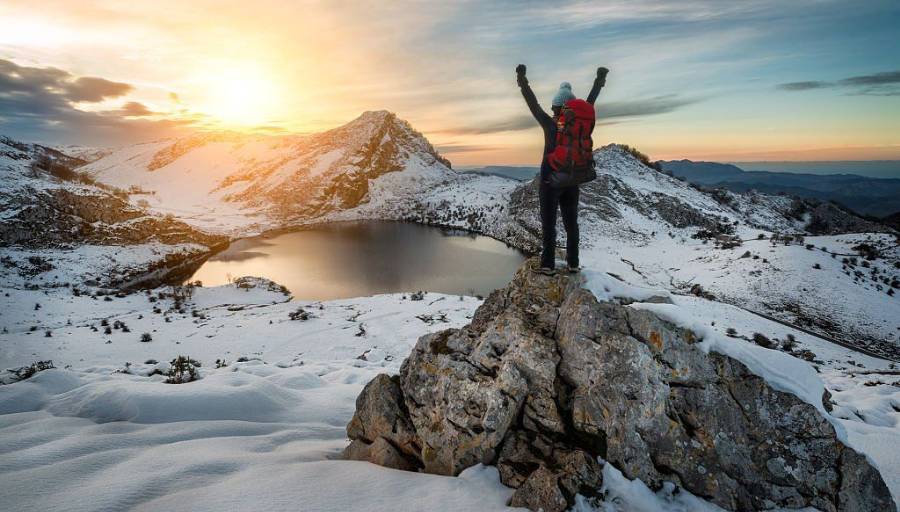
During Your Hike in the Snow
The winter trek also involves several precautions to be put in place in order to reduce the discomfort of cold and humidity and to avoid disappointments.
Stay Dry
To avoid falling ill or even, in the most extreme cases, hypothermia, it is strongly advised to protect yourself from internal (perspiration) and external humidity (cold, snow, frost). For this you will need:
- Wear adequate clothing as explained above.
- Regulate your body temperature.
- Keep your clothes dry by providing spares (especially the first layer) and in a waterproof shelter to avoid morning frosts.
- Choose your campsite carefully and remember to clear it so as not to pitch your tent on the wet snow.
- Provide a microfiber towel to dry your perspiration.
- Protect your hiking bag from bad weather with a suitable waterproof overlay.
Protect Yourself From the Wind
The wind is one of the great enemies of winter treks. Indeed, the wind has a direct impact on the perceived temperature. For this, some advice should be taken into account:
- Plan a third windproof layer with a hood.
- Close your clothes to avoid drafts.
- Choose areas sheltered from the wind for your breaks and bivouacs.
Pay Attention to Your Orientation
In winter, especially in snowy weather, the paths change completely. Indeed, topographic maps are made to represent the terrain in the summer period.
However, in snowy weather, the latter can attenuate certain reliefs, create others or even hide certain parts of the terrain. You will then have to be vigilant when planning your route and use orientation equipment such as a GPS or a compass. This will save you from getting lost or some mountain hiking accidents.
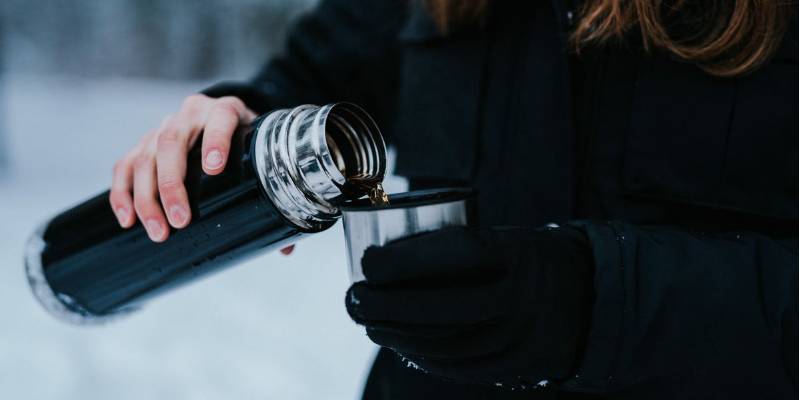
Hydrate Properly
Hydration is crucial when hiking because exercise causes you to lose a lot of water in the form of sweat. If in summer the heat and the sun are variables accentuating the dehydration, the winter humidity also. In addition, the lack of water can strongly promote hypothermia. You will then have to remember to hydrate yourself regularly.
Remember that when you feel thirsty, you are already dehydrated. So make sure to drink even when you don’t feel the need. If you are not tempted by ice water, you can prepare a hot drink in the morning such as herbal tea or tea that you keep in an insulated gourd.
Learn About Snow Ice Risks
The greatest danger of a winter hike remains snow or ice. Indeed, this type of terrain has many pitfalls:
- Disorientation due to Landscape Changes: Changes in the landscape can lead to disorientation, potentially causing you to deviate from your hiking route and risk getting lost.
- Avalanches: Mountains are prone to numerous and often unexpected avalanches, posing a significant hazard during winter expeditions.
- Hidden Hazards in Snow: Streams, ledges, and holes may be concealed beneath the snow, increasing the risk of falls and accidents.
- Increased Fatigue: Walking in snow demands more effort, making you prone to quicker exhaustion compared to summer hikes.
- Misleading Safety of Paths: Paths that are safe in summer may become treacherous in snowy conditions without the proper equipment and knowledge.
It is often preferable to prepare properly before a winter outing, to train for this type of circumstance, and to provide safety equipment (shovel, probe, detector of avalanche victims) in the most extreme cases.
Conclusion
I hope this article has provided valuable insights for those considering hiking and camping in snowy conditions! Remember, for extended multi-day treks, careful planning and physical preparation are paramount. By undertaking these measures, you can mitigate potential disappointments and optimize your readiness for a rewarding and safe excursion.
Happy adventuring! See you soon!

